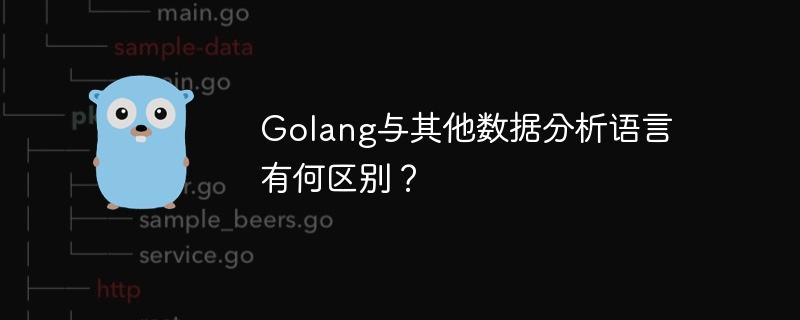
As a data analysis language, Go differs from Python, R, and Julia in the following four aspects: Concurrency: Go has built-in support for concurrency and can easily handle a large number of parallel tasks. Static typing: Go is a statically typed language, which improves code stability but limits development flexibility. Package management: Go uses Go modules to manage code, similar to Python's pip and R's CRAN. Syntax: Go's syntax is concise and easy to read, emphasizing clarity and conciseness, taking into account the characteristics of C and modern concepts.

Go compared to other data analysis languages: A closer look at the differences
Go (also known as Golang) is a modern, An efficient and concurrent programming language shows unique advantages when used for data analysis. However, it also differs from other popular data analysis languages. This article will dive into the differences between Go and languages like Python, R, and Julia, and provide practical examples to illustrate these differences.
Concurrency
One of Go’s most notable features is its built-in support for concurrency. It provides Goroutines, a very lightweight set of threads that can easily run multiple tasks simultaneously. This makes it very effective when working on large data analysis projects that require a lot of parallel tasks.
Static typing
Go is a statically typed language, which means that it requires the types of variables and functions to be specified at compile time. While this can bring advantages in terms of code stability and security, it also makes the development process more rigorous and disciplined compared to dynamically typed languages such as Python.
Package Management
Go uses a modular package management system called Go modules. This helps organize and manage code in a project, much like the package management systems of other languages such as Python's pip and R's CRAN.
Grammar
Go has a concise, highly readable syntax that emphasizes clarity and conciseness. It has some similarities to C but introduces modern concepts and features to make it easier to use and understand.
Community Support
Go has a large and active developer community that provides extensive documentation, resources, and support. This makes it easy to find answers, solve problems, and connect with other developers.
Practical Case
To illustrate the differences between Go and other languages, we create a simple example of using Go to process a large data set in parallel.
package main
import (
"fmt"
"math/rand"
"sync"
"time"
)
// 生成随机数数组
func generateRandomArray(size int) []int {
arr := make([]int, size)
for i := range arr {
arr[i] = rand.Intn(100)
}
return arr
}
// 使用并发性处理数组
func processArray(arr []int) {
var wg sync.WaitGroup
wg.Add(len(arr))
for _, v := range arr {
go func(num int) {
fmt.Printf("处理数字:%d\n", num)
time.Sleep(time.Duration(rand.Intn(100)) * time.Millisecond)
wg.Done()
}(v)
}
wg.Wait()
}
func main() {
// 生成 1000 个随机数的数组
arr := generateRandomArray(1000)
// 并行处理数组中的数字
start := time.Now()
processArray(arr)
fmt.Printf("并行处理用时:%v\n", time.Since(start))
}In this example, we use Goroutines to process numbers in an array in parallel. By taking advantage of Go's concurrency, we were able to significantly reduce the time required to process large data sets. This demonstrates the inherent advantages of Go compared to requiring the use of other libraries to achieve similar parallel implementations in Python or R.
Conclusion
Go offers a different set of functionality and features than other data analysis languages. Its concurrency, static typing, and simple syntax make it ideal for working on data analysis projects that require high performance and scalability. While other languages still have advantages in some areas, Go's unique advantages make it a strong choice worth considering.
The above is the detailed content of What is the difference between Golang and other data analysis languages?. For more information, please follow other related articles on the PHP Chinese website!




